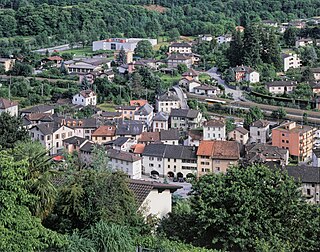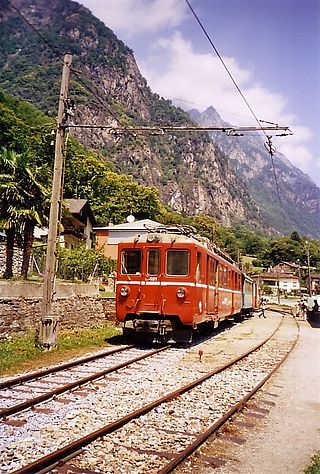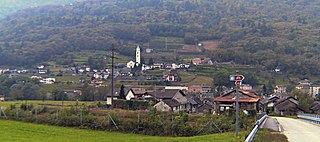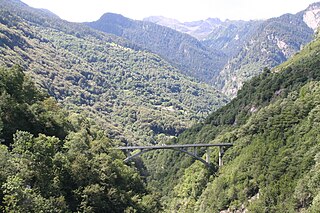
The river Ticino is the most important perennial left-bank tributary of the Po. It has given its name to the Swiss canton through which its upper portion flows.

The Grisons or Graubünden, more formally the Canton of the Grisons or the Canton of Graubünden, is one of the twenty-six cantons of Switzerland. It has eleven districts, and its capital is Chur. The German name of the canton, Graubünden, translates as the "Grey Leagues", referring to the canton's origin in three local alliances, the Three Leagues. The other native names also refer to the Grey League: Grischùn in Sutsilvan, Grischun in the other forms of Romansh, and Grigioni in Italian. Rhaetia is the Latin name for the area. The Alpine ibex is the canton's heraldic symbol.

There are 101 municipalities in the canton of Graubünden, Switzerland.

The A13 is a motorway, at times an Autostrasse (expressway), which runs from St. Margrethen in northeastern Switzerland through to Ascona in southern Switzerland, crossing the main chain of the Alps in the Grisons area. It is the southern half of European route E43.

Roveredo is a municipality in the Moesa Region in the canton of Graubünden in Switzerland.

Moesa District, often referred to as Moesano, is a former administrative district in the canton of Graubünden, Switzerland. It had an area of 473.74 km2 (182.91 sq mi) corresponding to the Val Mesolcina, the valley of the eponymous Moesa River. It was replaced with the Moesa Region on 1 January 2017 as part of a reorganization of the Canton.

The Bellinzona–Mesocco railway was a Swiss metre gauge railway that linked the towns of Bellinzona, in the canton of Ticino, and Mesocco, in the canton of Graubünden. The line was built by the Società Anonima della Ferrovia Elettrica Bellinzona-Mesocco and later became part of the Rhaetian Railway. Before complete closure, the section of the line between Castione-Arbedo, and Cama was operated by the Società Esercizio Ferroviario Turistico (SEFT) as a tourist railway known as the Ferrovia Mesolcinese.

The Three Leagues, sometimes referred to as Raetia, was the 1471 alliance between the League of God's House, the League of the Ten Jurisdictions, and the Grey League. Its members were all associates of the Old Swiss Confederacy, and as such enjoyed positive relations with the Confederation, which eventually led to the formation of the Swiss canton of Grisons.

Poschiavo is a municipality in the Bernina Region in the canton of Grisons in Switzerland.

Santa Maria in Calanca is a municipality in the Moesa Region in the Swiss canton of Graubünden.

Arvigo is a former municipality in the district of Moesa in the south of the Swiss canton of Graubünden, next to Ticino. On 1 January 2015 the former municipalities of Arvigo, Braggio, Cauco and Selma merged to form the new municipality of Calanca.

Cama is a municipality in the Moesa Region in the Swiss canton of Graubünden.

Castaneda is a municipality in the Moesa Region in the Swiss canton of Graubünden.
Grono is a municipality in the Moesa Region in the Italian speaking part of the Swiss canton of Grisons. On 1 January 2017 the former municipalities of Leggia and Verdabbio merged into the municipality of Grono.
Leggia is a former municipality in the district of Moesa in the Swiss canton of Graubünden. On 1 January 2017 the former municipalities of Leggia and Verdabbio merged into the municipality of Grono.

Mesocco is a municipality in the Moesa Region in the Swiss canton of Graubünden.

The Val Calanca is a valley of the Swiss Alps, located in the Lepontine Alps. The valley is drained by the Calancasca, a tributary of the Moesa, at Roveredo. The highest mountains surrounding the Val Calanca are the Puntone dei Fraciòn and the Zapporthorn.

Mesocco Castle is a ruined castle in the municipality of Mesocco of the Canton of Graubünden in Switzerland. It is a Swiss heritage site of national significance.

Santa Maria in Calanca Castle is a tower in the municipality of Santa Maria in Calanca of the Canton of Graubünden in Switzerland. It, along with the neighboring Church of the Assumption of St. Mary, are both Swiss heritage sites of national significance.

The noble family von Sax were a medieval noble family in eastern Switzerland. They owned estates and castles on both sides of the Alps in the modern cantons of St. Gallen, Graubünden and Ticino. The origin of the family is unknown, but they probably stem from Churrätien nobility and were related to the da Torre family. The family divided into two main lines; the Grafen (counts) von Sax-Misox and the Freiherren (barons) von Hohensax.


















